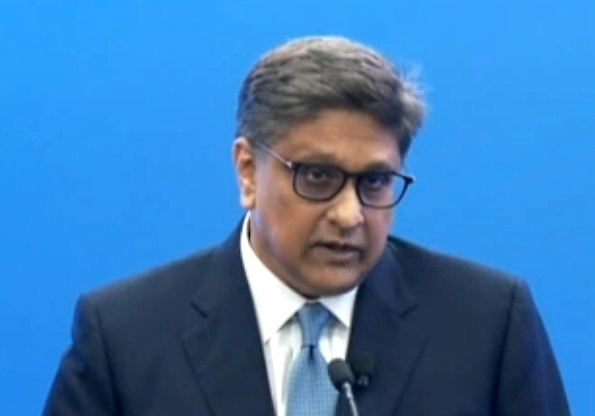
ANZ CFO Farhan Faruqui
ANZ reported net profit of A$3.5 billion for the six months to March – an increase of 20 per cent over the previous corresponding period.
After excluding one-off items, cash profit was up 4 per cent to $3.1 billion year-on year but was down 3 per cent from the September half last year. The biggest contributor to earnings growth during the half was a release from the collectively assessed provision.
Income: Net interest income rose 2 per cent over the previous corresponding period to $7.1 billion, although it was down 1 per cent from the September half. Other operating income rose 77 per cent to $2.4 billion. Total operating income rose 14 per cent to $9.5 billion.
Expenses and cost to income: Operating expenses rose 7 per cent to $4.8 billion. Of total expenses $3.7 billion was business as usual costs (unchanged from the previous half) and $900 million was investment spending. The ratio of operating expenses to operating income (on a cash basis) fell from 53.8 per cent in the March half 2021 to 50.5 per cent in the latest half.
Impairment expense: Individually assessed credit impairment charges were $87 million, which were more than offset by a collectively assessed credit impairment release of $371 million. The bank booked an impairment release of $284 million. The individually assessed credit impairment charge as a percentage of average gross loans and receivables was 3 basis points – down from 6 bps in the March half last year.
Credit quality: Gross impaired assets ($1.7 billion) as a percentage of net loans and advances fell from 40 bps to 26 bps year-on-year. Loans past due by 90 days or more fell 14 per cent to $2.8 billion. All loans past due but not impaired fell by 16 per cent to $9.5 billion.
Margin: The bank’s net interest margin rose from 1.63 per cent in the March half last year to 1.65 per cent in the September half but fell back 7 bps to 1.58 per cent in the latest half. Home loan pricing was the main element in the fall, along with a shift to lower margin fixed rate home loans. Growth in lower yielding liquid assets was also a drag.
Return on equity and assets: ROE was 11.3 per cent (10 per cent on a cash basis), compared with 9.5 per cent in the March half last year (9.7 per cent on a cash basis). Return on assets rose from 56 bps to 70 bps
Earnings per share: EPS rose 21 per cent to 125.7 cents a share. The payout ratio fell from 67.7 per cent in the March half last year to 57 per cent in the latest half.
Dividend: The bank declared an interim dividend of 72 cents a share, in line with the final dividend declared last September and up from 70 cents a share in the March half last year. On a cash basis, the dividend payout ratio fell from 66.6 per cent in the March half last year to 64.6 per cent in the latest half.
The divisions: The biggest of the group’s divisions, Australian retail and commercial, made a cash profit of $1.9 billion – an increase of 11 per cent over the previous corresponding period. The institutional division’s profit fell 23 per cent to $730 million. New Zealand profit rose 2 per cent to $787 million. The Pacific division lost $6 million, after making a profit of $7 million in the previous corresponding period.
Market share: According to APRA data, ANZ’s share of Australian housing lending is 13.8 per cent – down from 15 per cent a year earlier. Its share of Australian household deposits has fallen from 13.4 per cent to 13.2 per cent over the same period.
Capital: ANZ’s common equity tier 1 capital ratio was 11.5 per cent – down from 12.3 per cent in the September half and 12.4 per cent in the March half last year.
Liquidity and funding: The bank has total assets of $1 trillion, unchanged from the previous corresponding period. It has $651 billion of net loans and advances – up 6 per cent. Customer deposits rose 9 per cent year-on-year to $611 billion. The bank issued $6 billion of term wholesale funding with a term of greater than one year during the half. Total wholesale funding increased 6 per cent to $289 billion. The liquidity coverage ratio was 132 per cent and the net stable funding ratio 123 per cent.
Customer remediation: Remediation expenses rose from $108 million in the March half last year to $123 million in the latest half. Despite the increase, ANZ chief executive Shayne Elliott said the bank’s remediation program is in its final stages.